Detailed Case Study on Business and Corporate Law: Analysis Report
VerifiedAdded on 2020/04/15
|10
|1895
|86
Case Study
AI Summary
This document presents a detailed case study analysis of business and corporate law, addressing three distinct scenarios. The first case examines partnership law, specifically the obligations and liabilities of partners under the Partnership Act 1963, focusing on issues of contract adherence and potential legal actions. The second case delves into consumer law, analyzing the rights of a consumer and the implications of false advertising under the Australian Consumer Law. The third case explores employment law, specifically the Fair Work Act 2009, focusing on the rights of employees to incentives. The document provides legal analysis, relevant case law, and conclusions for each case, offering comprehensive insights into the practical application of business and corporate law principles. The cases cover various aspects of law like partnership, consumer rights, and employment regulations. This case study would be helpful for law students to understand the practical aspects of the law.
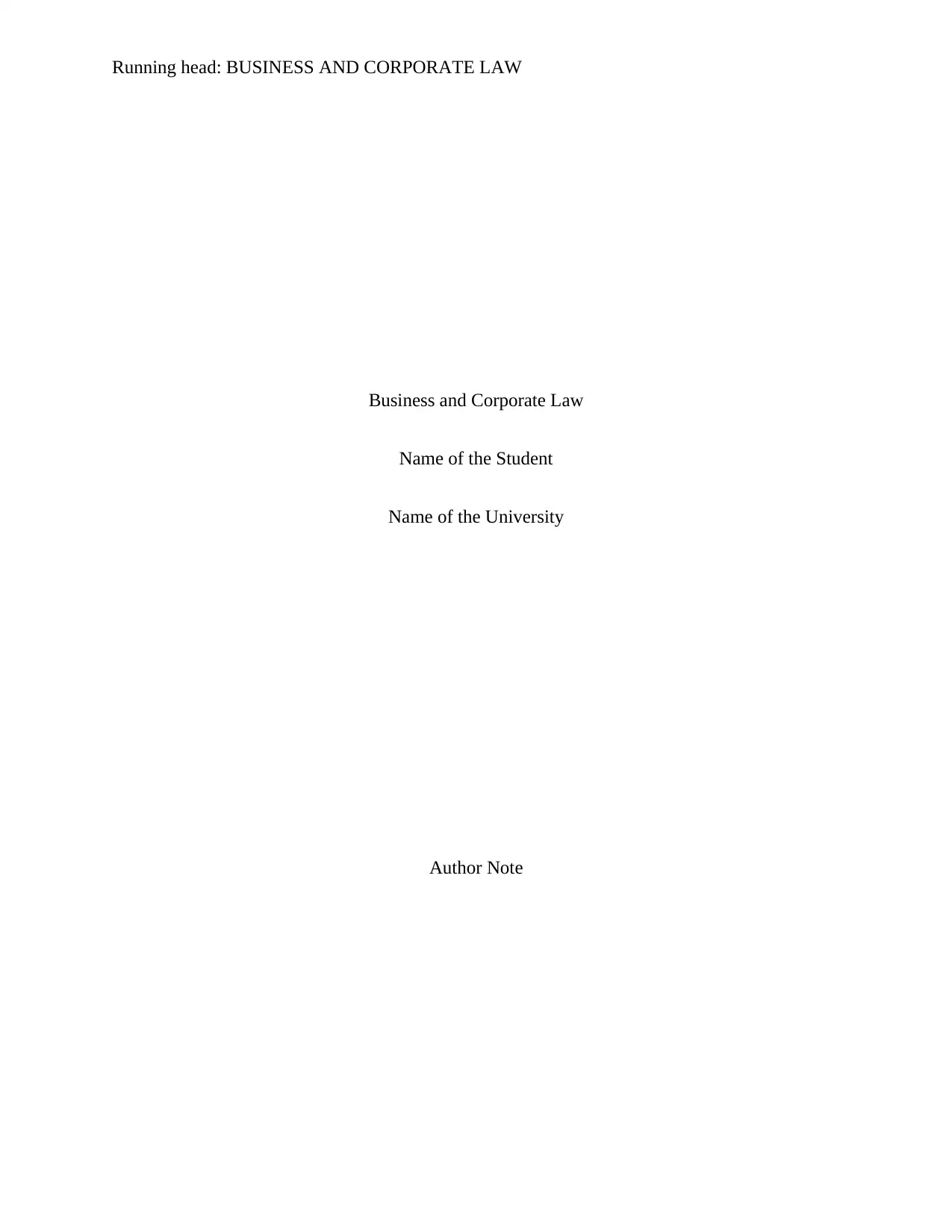
Running head: BUSINESS AND CORPORATE LAW
Business and Corporate Law
Name of the Student
Name of the University
Author Note
Business and Corporate Law
Name of the Student
Name of the University
Author Note
Paraphrase This Document
Need a fresh take? Get an instant paraphrase of this document with our AI Paraphraser
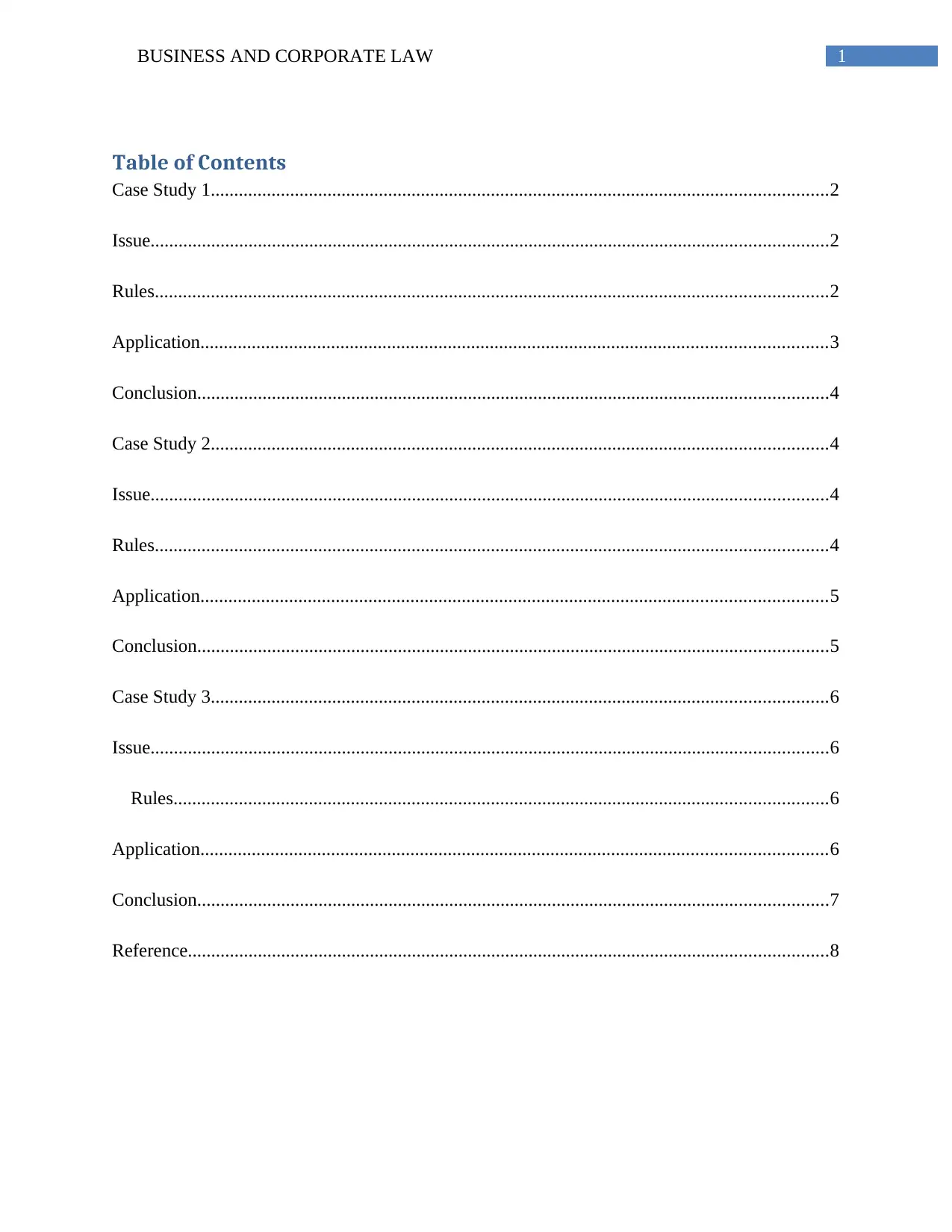
1BUSINESS AND CORPORATE LAW
Table of Contents
Case Study 1....................................................................................................................................2
Issue.................................................................................................................................................2
Rules................................................................................................................................................2
Application......................................................................................................................................3
Conclusion.......................................................................................................................................4
Case Study 2....................................................................................................................................4
Issue.................................................................................................................................................4
Rules................................................................................................................................................4
Application......................................................................................................................................5
Conclusion.......................................................................................................................................5
Case Study 3....................................................................................................................................6
Issue.................................................................................................................................................6
Rules............................................................................................................................................6
Application......................................................................................................................................6
Conclusion.......................................................................................................................................7
Reference.........................................................................................................................................8
Table of Contents
Case Study 1....................................................................................................................................2
Issue.................................................................................................................................................2
Rules................................................................................................................................................2
Application......................................................................................................................................3
Conclusion.......................................................................................................................................4
Case Study 2....................................................................................................................................4
Issue.................................................................................................................................................4
Rules................................................................................................................................................4
Application......................................................................................................................................5
Conclusion.......................................................................................................................................5
Case Study 3....................................................................................................................................6
Issue.................................................................................................................................................6
Rules............................................................................................................................................6
Application......................................................................................................................................6
Conclusion.......................................................................................................................................7
Reference.........................................................................................................................................8
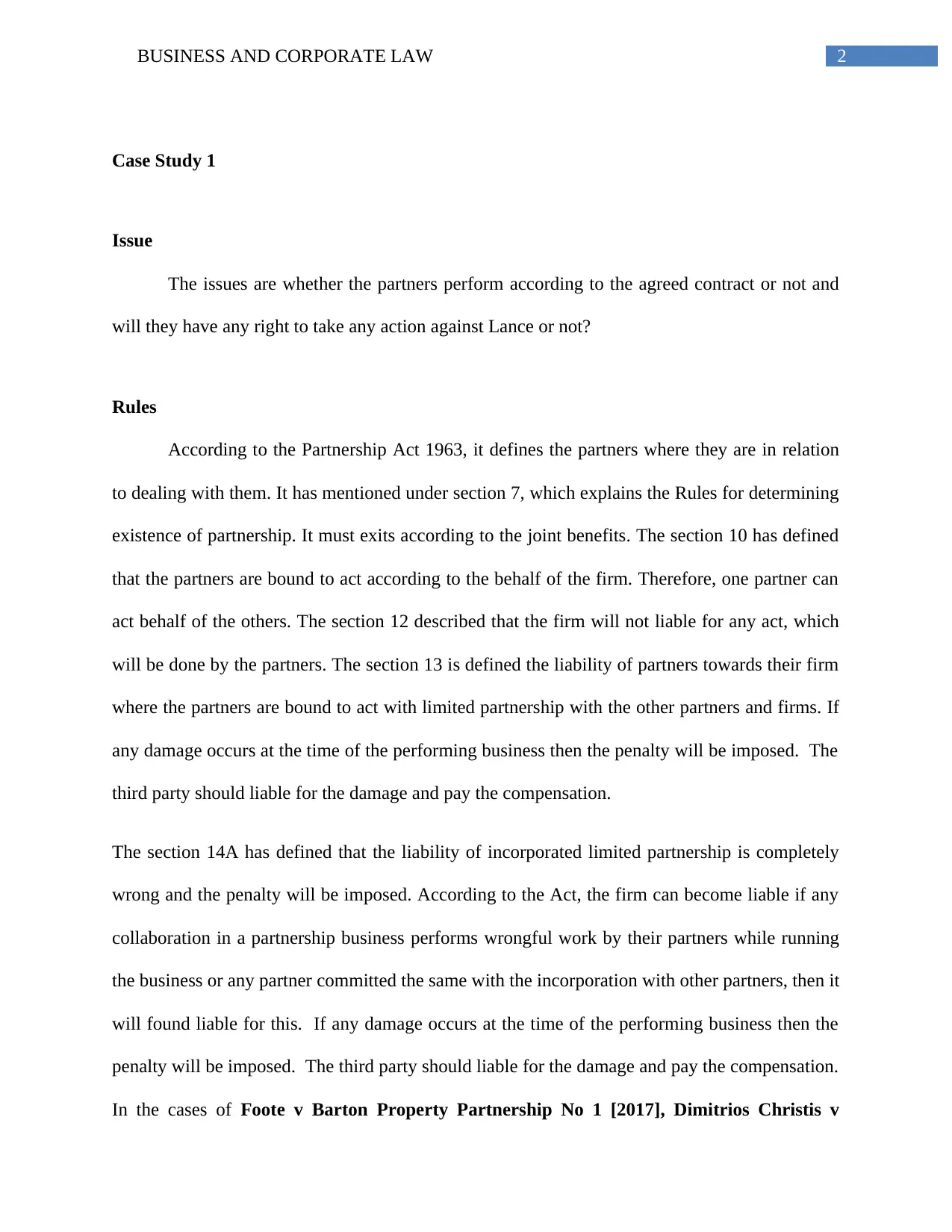
2BUSINESS AND CORPORATE LAW
Case Study 1
Issue
The issues are whether the partners perform according to the agreed contract or not and
will they have any right to take any action against Lance or not?
Rules
According to the Partnership Act 1963, it defines the partners where they are in relation
to dealing with them. It has mentioned under section 7, which explains the Rules for determining
existence of partnership. It must exits according to the joint benefits. The section 10 has defined
that the partners are bound to act according to the behalf of the firm. Therefore, one partner can
act behalf of the others. The section 12 described that the firm will not liable for any act, which
will be done by the partners. The section 13 is defined the liability of partners towards their firm
where the partners are bound to act with limited partnership with the other partners and firms. If
any damage occurs at the time of the performing business then the penalty will be imposed. The
third party should liable for the damage and pay the compensation.
The section 14A has defined that the liability of incorporated limited partnership is completely
wrong and the penalty will be imposed. According to the Act, the firm can become liable if any
collaboration in a partnership business performs wrongful work by their partners while running
the business or any partner committed the same with the incorporation with other partners, then it
will found liable for this. If any damage occurs at the time of the performing business then the
penalty will be imposed. The third party should liable for the damage and pay the compensation.
In the cases of Foote v Barton Property Partnership No 1 [2017], Dimitrios Christis v
Case Study 1
Issue
The issues are whether the partners perform according to the agreed contract or not and
will they have any right to take any action against Lance or not?
Rules
According to the Partnership Act 1963, it defines the partners where they are in relation
to dealing with them. It has mentioned under section 7, which explains the Rules for determining
existence of partnership. It must exits according to the joint benefits. The section 10 has defined
that the partners are bound to act according to the behalf of the firm. Therefore, one partner can
act behalf of the others. The section 12 described that the firm will not liable for any act, which
will be done by the partners. The section 13 is defined the liability of partners towards their firm
where the partners are bound to act with limited partnership with the other partners and firms. If
any damage occurs at the time of the performing business then the penalty will be imposed. The
third party should liable for the damage and pay the compensation.
The section 14A has defined that the liability of incorporated limited partnership is completely
wrong and the penalty will be imposed. According to the Act, the firm can become liable if any
collaboration in a partnership business performs wrongful work by their partners while running
the business or any partner committed the same with the incorporation with other partners, then it
will found liable for this. If any damage occurs at the time of the performing business then the
penalty will be imposed. The third party should liable for the damage and pay the compensation.
In the cases of Foote v Barton Property Partnership No 1 [2017], Dimitrios Christis v
⊘ This is a preview!⊘
Do you want full access?
Subscribe today to unlock all pages.

Trusted by 1+ million students worldwide
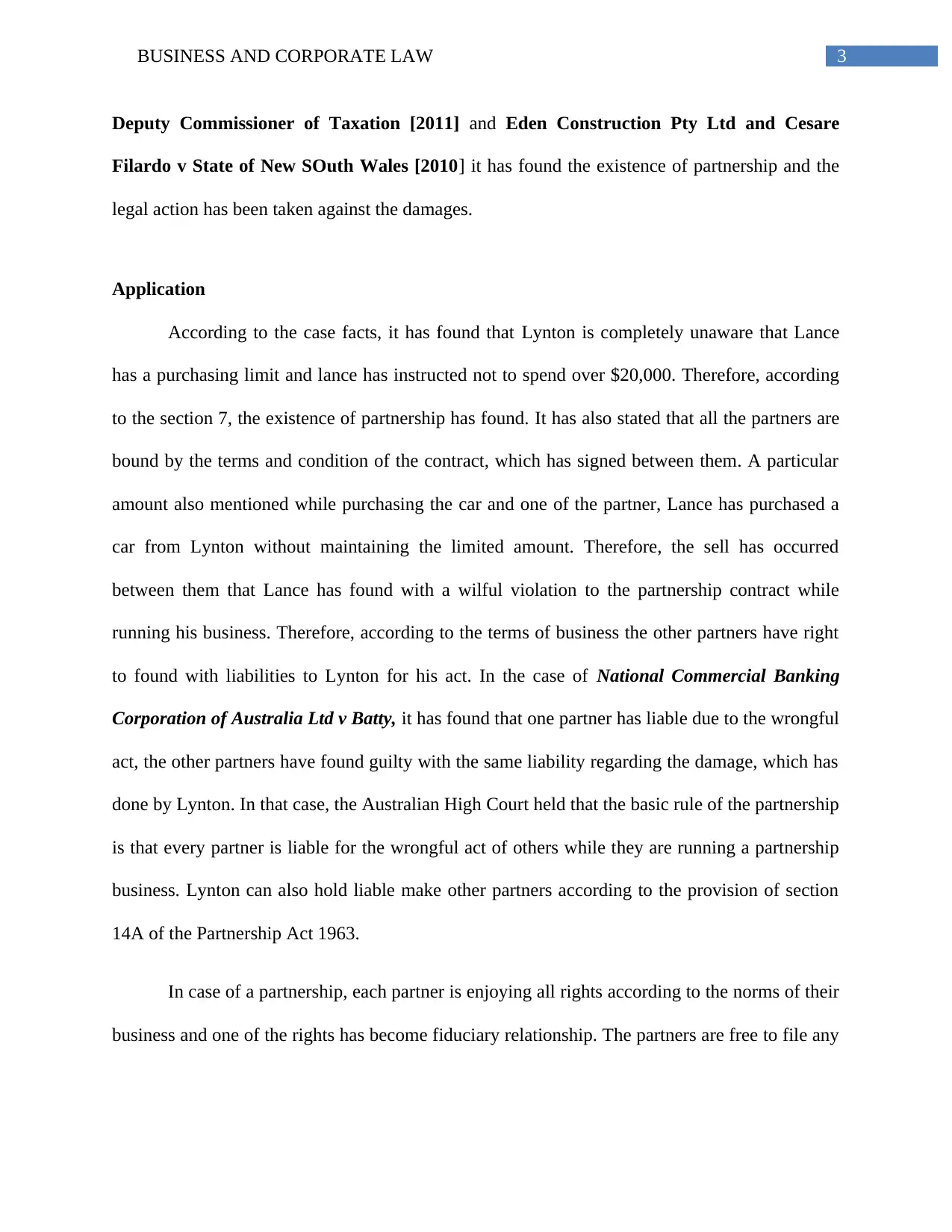
3BUSINESS AND CORPORATE LAW
Deputy Commissioner of Taxation [2011] and Eden Construction Pty Ltd and Cesare
Filardo v State of New SOuth Wales [2010] it has found the existence of partnership and the
legal action has been taken against the damages.
Application
According to the case facts, it has found that Lynton is completely unaware that Lance
has a purchasing limit and lance has instructed not to spend over $20,000. Therefore, according
to the section 7, the existence of partnership has found. It has also stated that all the partners are
bound by the terms and condition of the contract, which has signed between them. A particular
amount also mentioned while purchasing the car and one of the partner, Lance has purchased a
car from Lynton without maintaining the limited amount. Therefore, the sell has occurred
between them that Lance has found with a wilful violation to the partnership contract while
running his business. Therefore, according to the terms of business the other partners have right
to found with liabilities to Lynton for his act. In the case of National Commercial Banking
Corporation of Australia Ltd v Batty, it has found that one partner has liable due to the wrongful
act, the other partners have found guilty with the same liability regarding the damage, which has
done by Lynton. In that case, the Australian High Court held that the basic rule of the partnership
is that every partner is liable for the wrongful act of others while they are running a partnership
business. Lynton can also hold liable make other partners according to the provision of section
14A of the Partnership Act 1963.
In case of a partnership, each partner is enjoying all rights according to the norms of their
business and one of the rights has become fiduciary relationship. The partners are free to file any
Deputy Commissioner of Taxation [2011] and Eden Construction Pty Ltd and Cesare
Filardo v State of New SOuth Wales [2010] it has found the existence of partnership and the
legal action has been taken against the damages.
Application
According to the case facts, it has found that Lynton is completely unaware that Lance
has a purchasing limit and lance has instructed not to spend over $20,000. Therefore, according
to the section 7, the existence of partnership has found. It has also stated that all the partners are
bound by the terms and condition of the contract, which has signed between them. A particular
amount also mentioned while purchasing the car and one of the partner, Lance has purchased a
car from Lynton without maintaining the limited amount. Therefore, the sell has occurred
between them that Lance has found with a wilful violation to the partnership contract while
running his business. Therefore, according to the terms of business the other partners have right
to found with liabilities to Lynton for his act. In the case of National Commercial Banking
Corporation of Australia Ltd v Batty, it has found that one partner has liable due to the wrongful
act, the other partners have found guilty with the same liability regarding the damage, which has
done by Lynton. In that case, the Australian High Court held that the basic rule of the partnership
is that every partner is liable for the wrongful act of others while they are running a partnership
business. Lynton can also hold liable make other partners according to the provision of section
14A of the Partnership Act 1963.
In case of a partnership, each partner is enjoying all rights according to the norms of their
business and one of the rights has become fiduciary relationship. The partners are free to file any
Paraphrase This Document
Need a fresh take? Get an instant paraphrase of this document with our AI Paraphraser
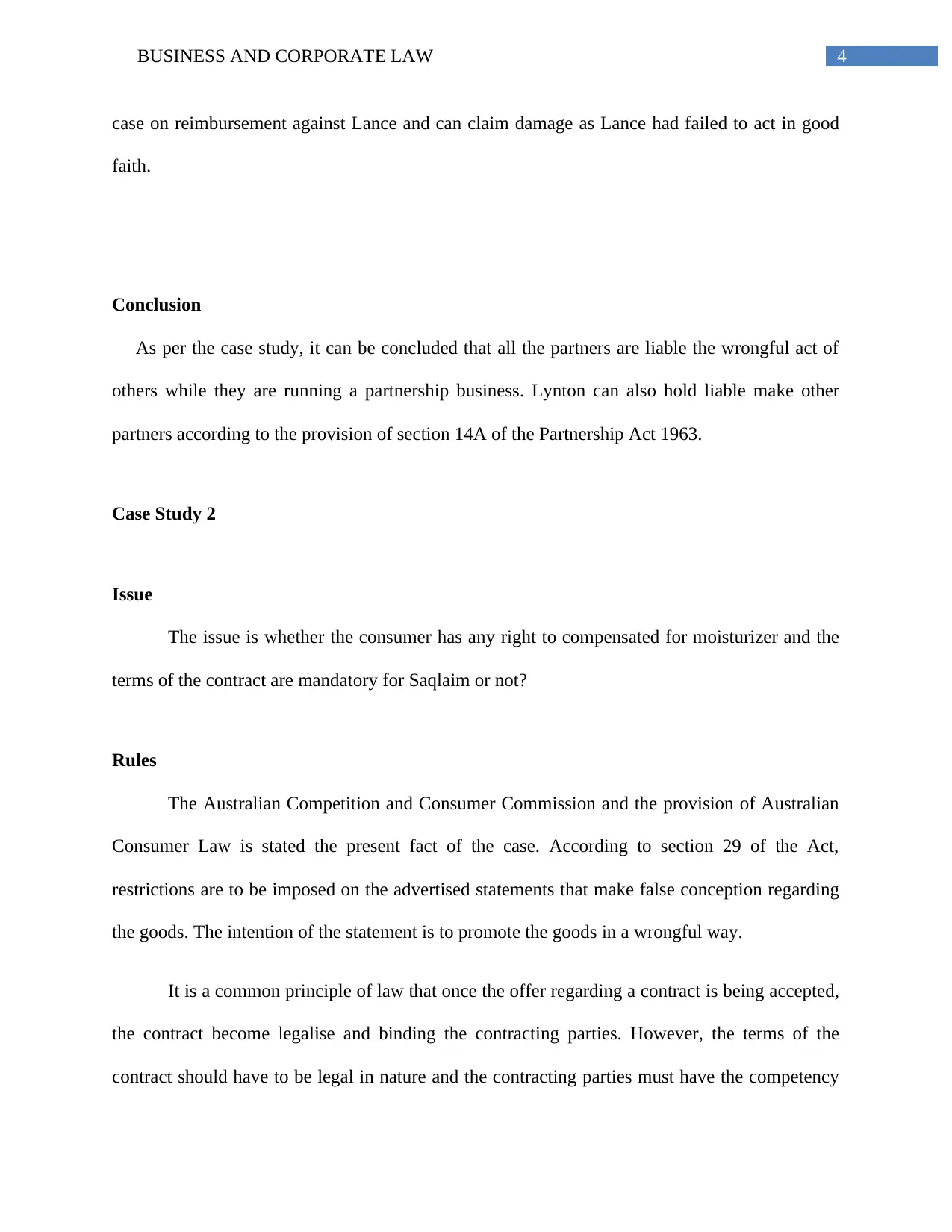
4BUSINESS AND CORPORATE LAW
case on reimbursement against Lance and can claim damage as Lance had failed to act in good
faith.
Conclusion
As per the case study, it can be concluded that all the partners are liable the wrongful act of
others while they are running a partnership business. Lynton can also hold liable make other
partners according to the provision of section 14A of the Partnership Act 1963.
Case Study 2
Issue
The issue is whether the consumer has any right to compensated for moisturizer and the
terms of the contract are mandatory for Saqlaim or not?
Rules
The Australian Competition and Consumer Commission and the provision of Australian
Consumer Law is stated the present fact of the case. According to section 29 of the Act,
restrictions are to be imposed on the advertised statements that make false conception regarding
the goods. The intention of the statement is to promote the goods in a wrongful way.
It is a common principle of law that once the offer regarding a contract is being accepted,
the contract become legalise and binding the contracting parties. However, the terms of the
contract should have to be legal in nature and the contracting parties must have the competency
case on reimbursement against Lance and can claim damage as Lance had failed to act in good
faith.
Conclusion
As per the case study, it can be concluded that all the partners are liable the wrongful act of
others while they are running a partnership business. Lynton can also hold liable make other
partners according to the provision of section 14A of the Partnership Act 1963.
Case Study 2
Issue
The issue is whether the consumer has any right to compensated for moisturizer and the
terms of the contract are mandatory for Saqlaim or not?
Rules
The Australian Competition and Consumer Commission and the provision of Australian
Consumer Law is stated the present fact of the case. According to section 29 of the Act,
restrictions are to be imposed on the advertised statements that make false conception regarding
the goods. The intention of the statement is to promote the goods in a wrongful way.
It is a common principle of law that once the offer regarding a contract is being accepted,
the contract become legalise and binding the contracting parties. However, the terms of the
contract should have to be legal in nature and the contracting parties must have the competency
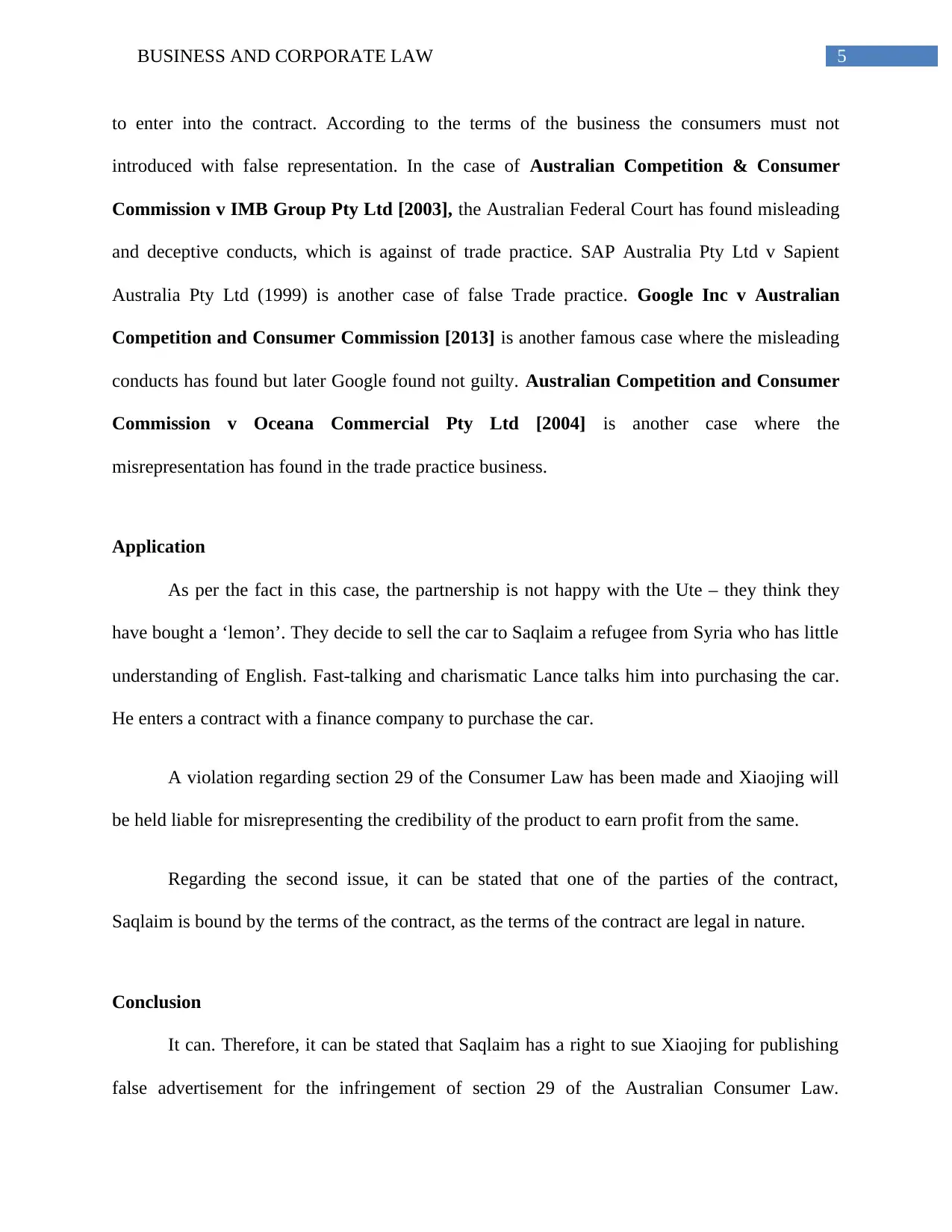
5BUSINESS AND CORPORATE LAW
to enter into the contract. According to the terms of the business the consumers must not
introduced with false representation. In the case of Australian Competition & Consumer
Commission v IMB Group Pty Ltd [2003], the Australian Federal Court has found misleading
and deceptive conducts, which is against of trade practice. SAP Australia Pty Ltd v Sapient
Australia Pty Ltd (1999) is another case of false Trade practice. Google Inc v Australian
Competition and Consumer Commission [2013] is another famous case where the misleading
conducts has found but later Google found not guilty. Australian Competition and Consumer
Commission v Oceana Commercial Pty Ltd [2004] is another case where the
misrepresentation has found in the trade practice business.
Application
As per the fact in this case, the partnership is not happy with the Ute – they think they
have bought a ‘lemon’. They decide to sell the car to Saqlaim a refugee from Syria who has little
understanding of English. Fast-talking and charismatic Lance talks him into purchasing the car.
He enters a contract with a finance company to purchase the car.
A violation regarding section 29 of the Consumer Law has been made and Xiaojing will
be held liable for misrepresenting the credibility of the product to earn profit from the same.
Regarding the second issue, it can be stated that one of the parties of the contract,
Saqlaim is bound by the terms of the contract, as the terms of the contract are legal in nature.
Conclusion
It can. Therefore, it can be stated that Saqlaim has a right to sue Xiaojing for publishing
false advertisement for the infringement of section 29 of the Australian Consumer Law.
to enter into the contract. According to the terms of the business the consumers must not
introduced with false representation. In the case of Australian Competition & Consumer
Commission v IMB Group Pty Ltd [2003], the Australian Federal Court has found misleading
and deceptive conducts, which is against of trade practice. SAP Australia Pty Ltd v Sapient
Australia Pty Ltd (1999) is another case of false Trade practice. Google Inc v Australian
Competition and Consumer Commission [2013] is another famous case where the misleading
conducts has found but later Google found not guilty. Australian Competition and Consumer
Commission v Oceana Commercial Pty Ltd [2004] is another case where the
misrepresentation has found in the trade practice business.
Application
As per the fact in this case, the partnership is not happy with the Ute – they think they
have bought a ‘lemon’. They decide to sell the car to Saqlaim a refugee from Syria who has little
understanding of English. Fast-talking and charismatic Lance talks him into purchasing the car.
He enters a contract with a finance company to purchase the car.
A violation regarding section 29 of the Consumer Law has been made and Xiaojing will
be held liable for misrepresenting the credibility of the product to earn profit from the same.
Regarding the second issue, it can be stated that one of the parties of the contract,
Saqlaim is bound by the terms of the contract, as the terms of the contract are legal in nature.
Conclusion
It can. Therefore, it can be stated that Saqlaim has a right to sue Xiaojing for publishing
false advertisement for the infringement of section 29 of the Australian Consumer Law.
⊘ This is a preview!⊘
Do you want full access?
Subscribe today to unlock all pages.

Trusted by 1+ million students worldwide
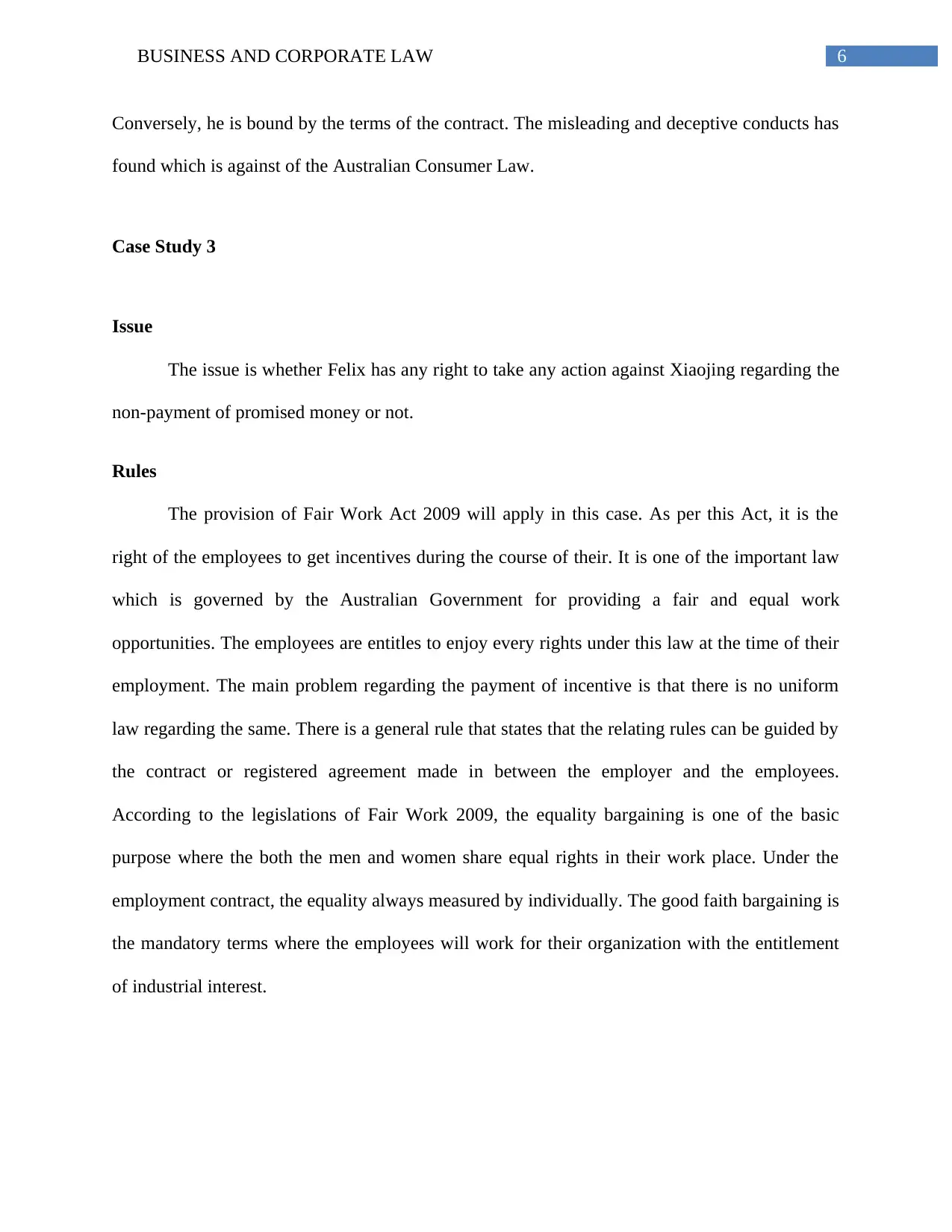
6BUSINESS AND CORPORATE LAW
Conversely, he is bound by the terms of the contract. The misleading and deceptive conducts has
found which is against of the Australian Consumer Law.
Case Study 3
Issue
The issue is whether Felix has any right to take any action against Xiaojing regarding the
non-payment of promised money or not.
Rules
The provision of Fair Work Act 2009 will apply in this case. As per this Act, it is the
right of the employees to get incentives during the course of their. It is one of the important law
which is governed by the Australian Government for providing a fair and equal work
opportunities. The employees are entitles to enjoy every rights under this law at the time of their
employment. The main problem regarding the payment of incentive is that there is no uniform
law regarding the same. There is a general rule that states that the relating rules can be guided by
the contract or registered agreement made in between the employer and the employees.
According to the legislations of Fair Work 2009, the equality bargaining is one of the basic
purpose where the both the men and women share equal rights in their work place. Under the
employment contract, the equality always measured by individually. The good faith bargaining is
the mandatory terms where the employees will work for their organization with the entitlement
of industrial interest.
Conversely, he is bound by the terms of the contract. The misleading and deceptive conducts has
found which is against of the Australian Consumer Law.
Case Study 3
Issue
The issue is whether Felix has any right to take any action against Xiaojing regarding the
non-payment of promised money or not.
Rules
The provision of Fair Work Act 2009 will apply in this case. As per this Act, it is the
right of the employees to get incentives during the course of their. It is one of the important law
which is governed by the Australian Government for providing a fair and equal work
opportunities. The employees are entitles to enjoy every rights under this law at the time of their
employment. The main problem regarding the payment of incentive is that there is no uniform
law regarding the same. There is a general rule that states that the relating rules can be guided by
the contract or registered agreement made in between the employer and the employees.
According to the legislations of Fair Work 2009, the equality bargaining is one of the basic
purpose where the both the men and women share equal rights in their work place. Under the
employment contract, the equality always measured by individually. The good faith bargaining is
the mandatory terms where the employees will work for their organization with the entitlement
of industrial interest.
Paraphrase This Document
Need a fresh take? Get an instant paraphrase of this document with our AI Paraphraser
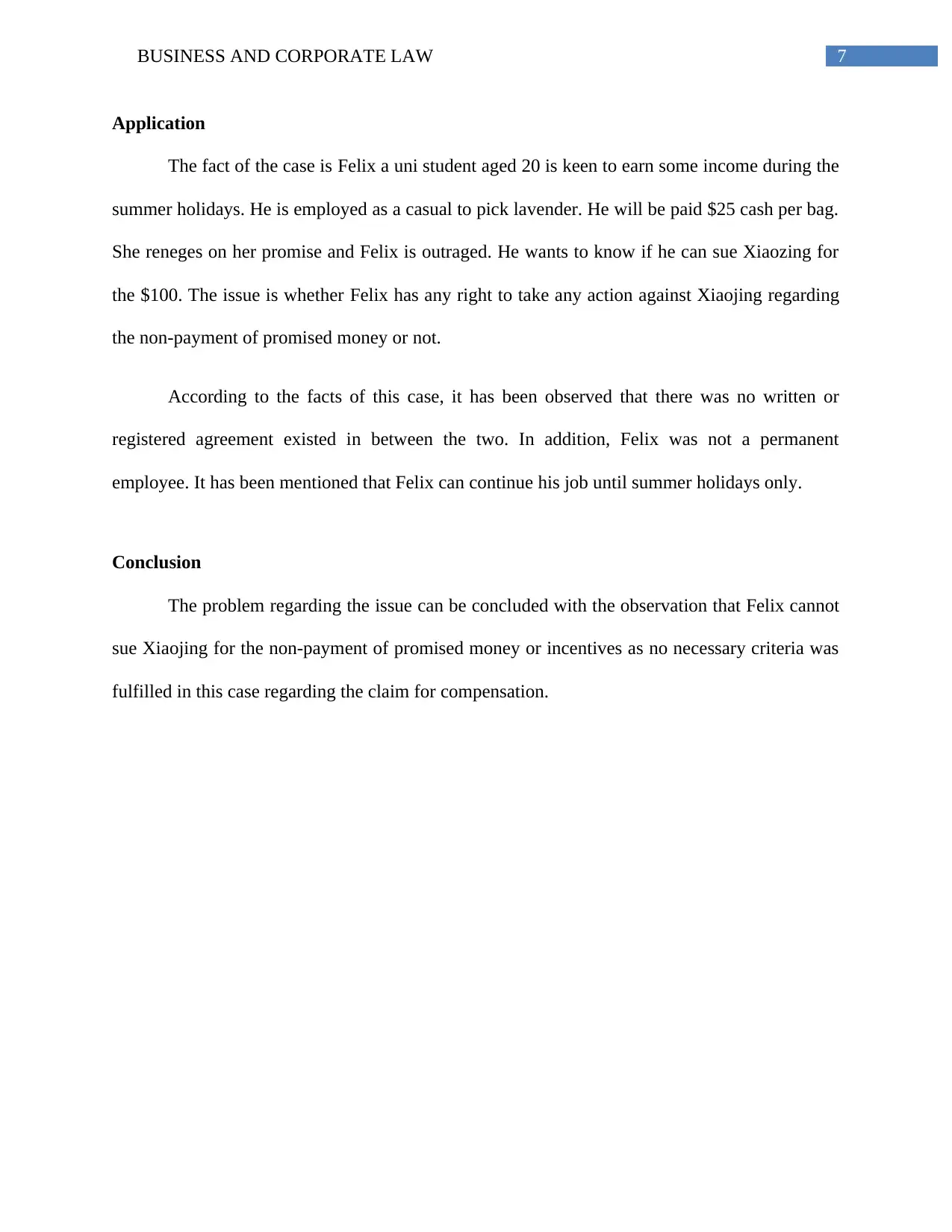
7BUSINESS AND CORPORATE LAW
Application
The fact of the case is Felix a uni student aged 20 is keen to earn some income during the
summer holidays. He is employed as a casual to pick lavender. He will be paid $25 cash per bag.
She reneges on her promise and Felix is outraged. He wants to know if he can sue Xiaozing for
the $100. The issue is whether Felix has any right to take any action against Xiaojing regarding
the non-payment of promised money or not.
According to the facts of this case, it has been observed that there was no written or
registered agreement existed in between the two. In addition, Felix was not a permanent
employee. It has been mentioned that Felix can continue his job until summer holidays only.
Conclusion
The problem regarding the issue can be concluded with the observation that Felix cannot
sue Xiaojing for the non-payment of promised money or incentives as no necessary criteria was
fulfilled in this case regarding the claim for compensation.
Application
The fact of the case is Felix a uni student aged 20 is keen to earn some income during the
summer holidays. He is employed as a casual to pick lavender. He will be paid $25 cash per bag.
She reneges on her promise and Felix is outraged. He wants to know if he can sue Xiaozing for
the $100. The issue is whether Felix has any right to take any action against Xiaojing regarding
the non-payment of promised money or not.
According to the facts of this case, it has been observed that there was no written or
registered agreement existed in between the two. In addition, Felix was not a permanent
employee. It has been mentioned that Felix can continue his job until summer holidays only.
Conclusion
The problem regarding the issue can be concluded with the observation that Felix cannot
sue Xiaojing for the non-payment of promised money or incentives as no necessary criteria was
fulfilled in this case regarding the claim for compensation.
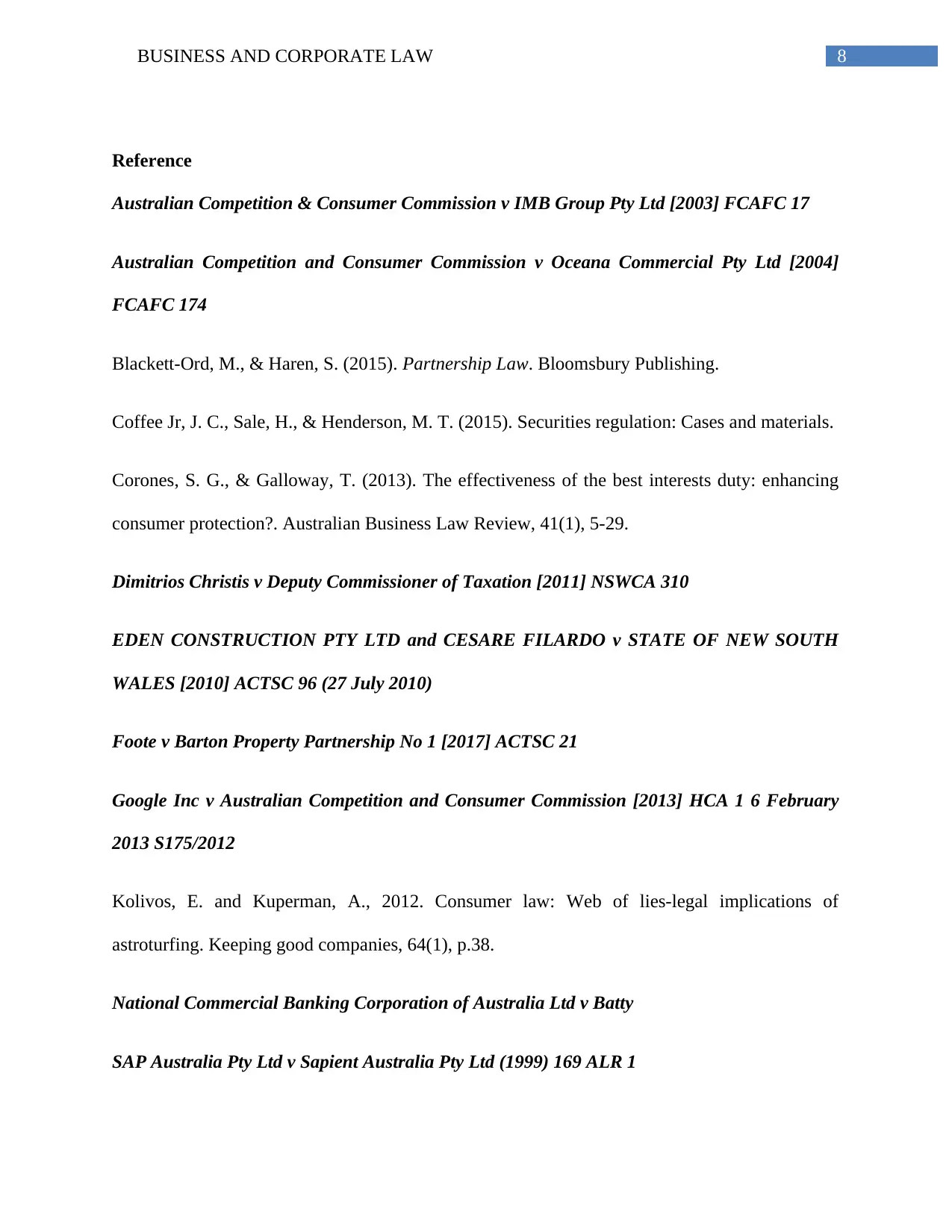
8BUSINESS AND CORPORATE LAW
Reference
Australian Competition & Consumer Commission v IMB Group Pty Ltd [2003] FCAFC 17
Australian Competition and Consumer Commission v Oceana Commercial Pty Ltd [2004]
FCAFC 174
Blackett-Ord, M., & Haren, S. (2015). Partnership Law. Bloomsbury Publishing.
Coffee Jr, J. C., Sale, H., & Henderson, M. T. (2015). Securities regulation: Cases and materials.
Corones, S. G., & Galloway, T. (2013). The effectiveness of the best interests duty: enhancing
consumer protection?. Australian Business Law Review, 41(1), 5-29.
Dimitrios Christis v Deputy Commissioner of Taxation [2011] NSWCA 310
EDEN CONSTRUCTION PTY LTD and CESARE FILARDO v STATE OF NEW SOUTH
WALES [2010] ACTSC 96 (27 July 2010)
Foote v Barton Property Partnership No 1 [2017] ACTSC 21
Google Inc v Australian Competition and Consumer Commission [2013] HCA 1 6 February
2013 S175/2012
Kolivos, E. and Kuperman, A., 2012. Consumer law: Web of lies-legal implications of
astroturfing. Keeping good companies, 64(1), p.38.
National Commercial Banking Corporation of Australia Ltd v Batty
SAP Australia Pty Ltd v Sapient Australia Pty Ltd (1999) 169 ALR 1
Reference
Australian Competition & Consumer Commission v IMB Group Pty Ltd [2003] FCAFC 17
Australian Competition and Consumer Commission v Oceana Commercial Pty Ltd [2004]
FCAFC 174
Blackett-Ord, M., & Haren, S. (2015). Partnership Law. Bloomsbury Publishing.
Coffee Jr, J. C., Sale, H., & Henderson, M. T. (2015). Securities regulation: Cases and materials.
Corones, S. G., & Galloway, T. (2013). The effectiveness of the best interests duty: enhancing
consumer protection?. Australian Business Law Review, 41(1), 5-29.
Dimitrios Christis v Deputy Commissioner of Taxation [2011] NSWCA 310
EDEN CONSTRUCTION PTY LTD and CESARE FILARDO v STATE OF NEW SOUTH
WALES [2010] ACTSC 96 (27 July 2010)
Foote v Barton Property Partnership No 1 [2017] ACTSC 21
Google Inc v Australian Competition and Consumer Commission [2013] HCA 1 6 February
2013 S175/2012
Kolivos, E. and Kuperman, A., 2012. Consumer law: Web of lies-legal implications of
astroturfing. Keeping good companies, 64(1), p.38.
National Commercial Banking Corporation of Australia Ltd v Batty
SAP Australia Pty Ltd v Sapient Australia Pty Ltd (1999) 169 ALR 1
⊘ This is a preview!⊘
Do you want full access?
Subscribe today to unlock all pages.

Trusted by 1+ million students worldwide
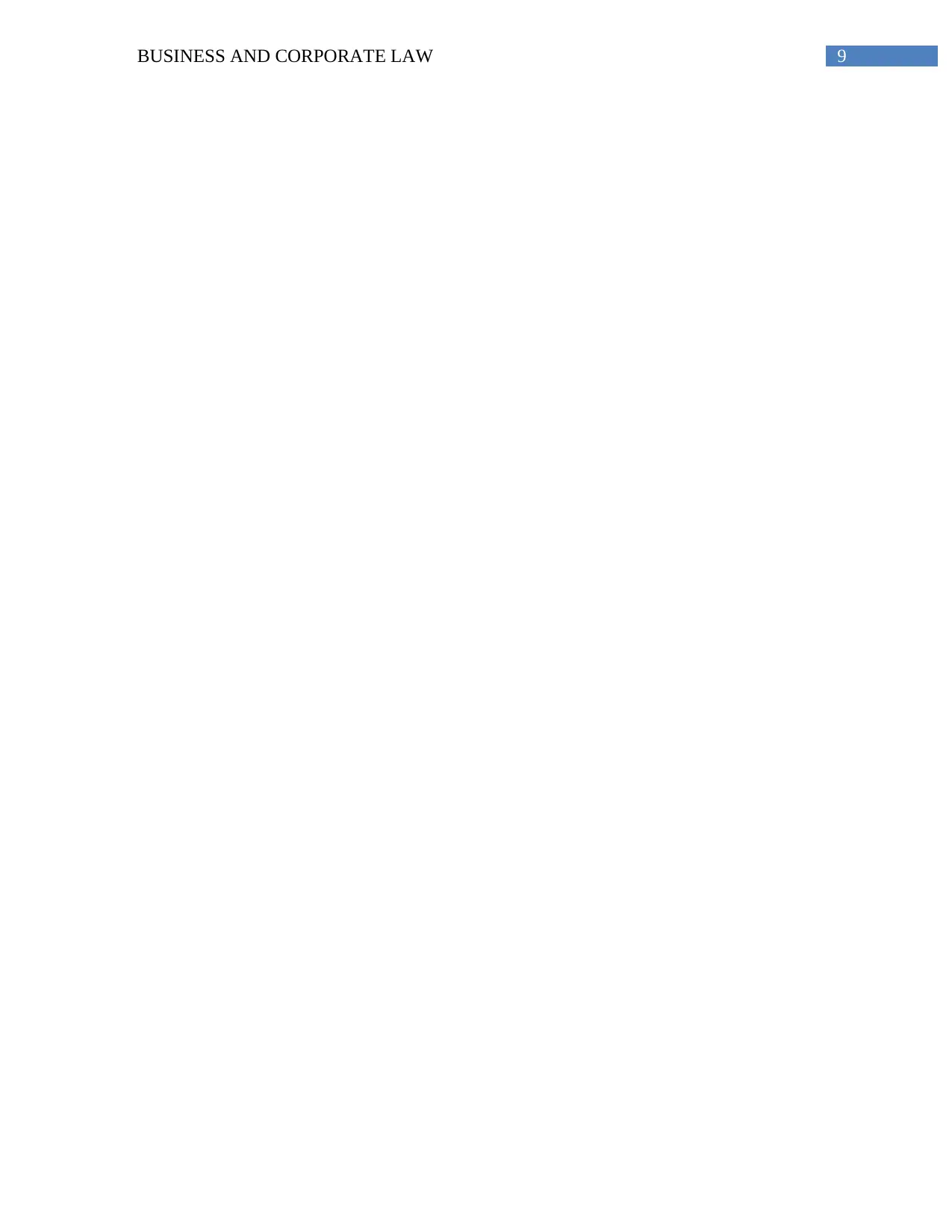
9BUSINESS AND CORPORATE LAW
1 out of 10
Related Documents
Your All-in-One AI-Powered Toolkit for Academic Success.
+13062052269
info@desklib.com
Available 24*7 on WhatsApp / Email
![[object Object]](/_next/static/media/star-bottom.7253800d.svg)
Unlock your academic potential
Copyright © 2020–2025 A2Z Services. All Rights Reserved. Developed and managed by ZUCOL.



